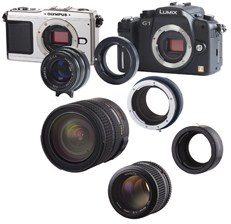 If you have a nice lens that you’d like to use with a camera of a different brand, Novoflex probably has an adapter that will let you do that. With the Novoflex Adapters, you can marry up camera bodies and lenses with different bayonet mounts. No functions will be transferred; you’ll have to adjust the lens manually. Novoflex suggests using the stop-down metering/aperture priority. They also warn that physical limitations – “flange focal length difference” – mean not every camera/lens combination is possible. Prices vary depending on the combination. Novoflex seems to be a German company, but they sell internationally. Visit their dealer finder page to find one near you.
If you have a nice lens that you’d like to use with a camera of a different brand, Novoflex probably has an adapter that will let you do that. With the Novoflex Adapters, you can marry up camera bodies and lenses with different bayonet mounts. No functions will be transferred; you’ll have to adjust the lens manually. Novoflex suggests using the stop-down metering/aperture priority. They also warn that physical limitations – “flange focal length difference” – mean not every camera/lens combination is possible. Prices vary depending on the combination. Novoflex seems to be a German company, but they sell internationally. Visit their dealer finder page to find one near you.



Gadgeteer Comment Policy - Please read before commenting
Not vice-versa. Nikon lenses have the longest distance from the imaging plane to the lens mount, so you can add an adapter for a mount with shorter mount-to-sensor distance and adapt a Nikon lens to Canon. Vice-versa is not possible.
@BJN Oops! See, not every combination possible! Thanks for pointing out my mistake. I didn’t go through every possible combination in their listings. I edited the title to correct my mistake.
Systems with larger “flange” distances (e.g. Nikon, Olympus OM, etc.) are “universal donors.” i.e. their lenses can be used (in manual mode) with more camera systems with relatively simple physical adapters, but their bodies can only take relatively few lenses.
Systems with shorter flange distances (i.e. Canon, FourThirds) are “univeral acceptors.” I.e. their bodies can take more lenses with simple adapters, but their lenses are relatively limited in use.
The newer “EVIL” cameras (i.e. Electronic viewfinder, interchangeable lens) such as µ4/3 and similar models from Sony and Samsung are noted for having much shorter flange distances and can use almost any SLR lens with appropriate adapter.
Nikon lens + Canon Body is easy. The reverse, less so.
It is possible to create an adapter to allow the use of shorter flange lenses with longer flange bodies, but doing so introduces compromises. A simple adapter would likely lose the ability to focus the lens at infinity. The lens, with sufficient manual controls, would work fine as a macro lens in that case as the adapter/camera would basically act as an extension tube.
It may be possible to create an adapter that adds optical elements to correct for the flange differential, but those would either be expensive or compromise quality. For example, Canon made some of those for adapting their old FD lenses to the EF bodies.
Because of all this, if you’re ever interested in purchasing a manual-only lens that is available in multiple mounts, I highly suggest getting the Nikon-mount (i.e. longer flange) version and purchasing an adapter. If you do so and eventually decide to resell the lens down the road, virtually any DSLR user would potentially be able to use the lens. If you buy a shorter flange mount, the market is diminished.
Novoflex is indeed a german company with a wide range of high quality camera accessories. By using the manual lens adapters you should be aware of the following restrictions:
– Your camera can not set the aperture of the lens. The aperture reading on the camera display will usually be “0.0”. If the lens is an old MF-Model it may have an aperture ring, but by decreasing the aperture, the viewfinder will darken. If the lens has no aperture ring (like most modern AF lenses), you can only use maximum aperture/minimal depth of field.
– Autofocus and lens-based image-stabilization will not work.
When I made the switch to digital from Leica Film, I knew I’d be buying into a whole new system versus just buying a new body. I looked at the best Olympus, Canon and Nikon had to offer, and what made me choose Canon was the fact that I could still mount and use my Leica glass on the new body! This let me slowly build up my EOS L glass, without having to rush to replace my Leica lenses. Now I have a good mix that does everything I could ask for.